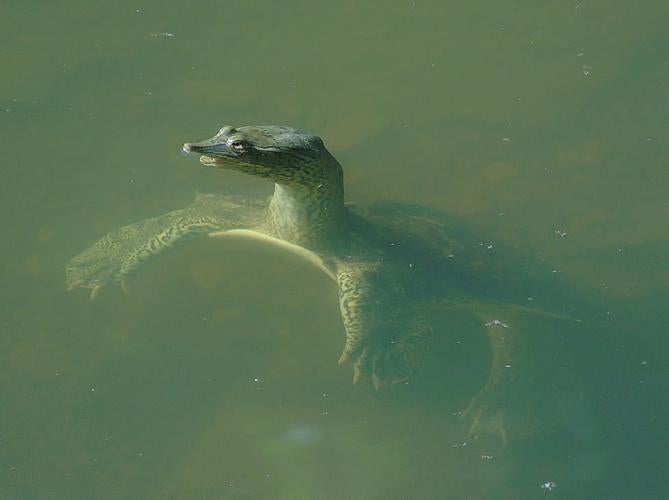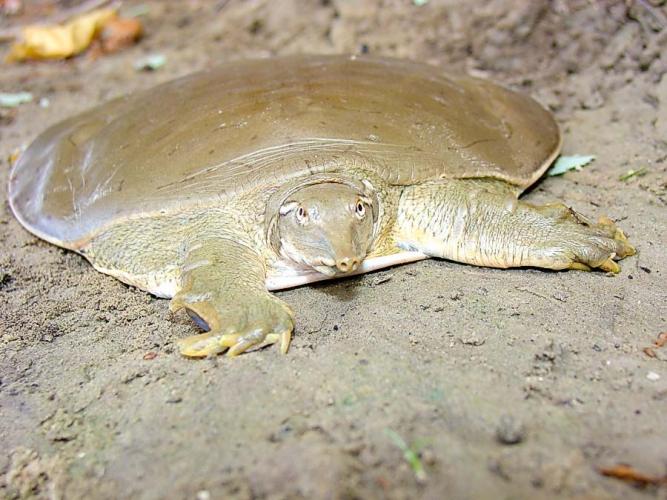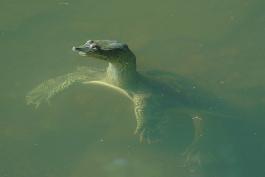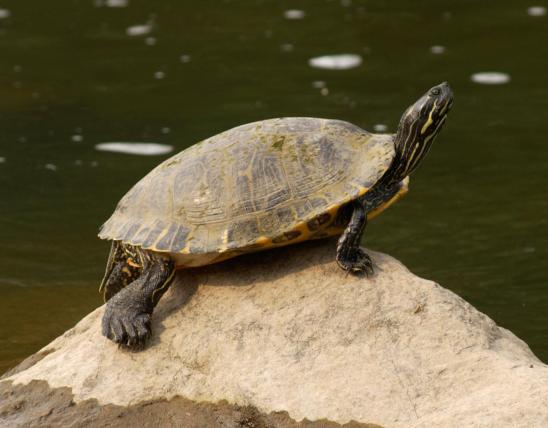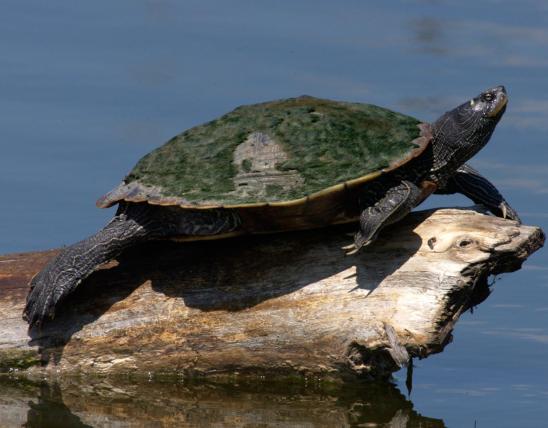
The midland smooth softshell is a rather plain-looking softshell turtle. The front of the carapace (top shell) lacks any small bumps or spines, and the overall shell is quite smooth. The carapace may be olive gray or brown; males and young may have faint markings in the form of dots and dashes. Adult females have a mottled carapace with blotches of gray, olive, or brown. The plastron (lower shell) may be gray or cream colored and lacks any markings; however, the underlying bones are usually visible. The neck and limbs are olive or gray above, and white or cream colored below. A light stripe bordered by black extends backward from each eye along the sides of the head.
Lacking a hard shell, softshells defend themselves by being fast swimmers. They also use their strong, sharp claws to defend themselves when picked up. They should be handled very carefully to avoid injury.
Similar species: Missouri has two species of softshells. Both live primarily in rivers but also are known to occur in large reservoirs. Our other species, the spiny softshell (A. spinifera), has spines or bumps along the front edge of the upper shell.
Adult upper shell length: 6½ to 14 inches (females); 4½ to 10½ inches (males).
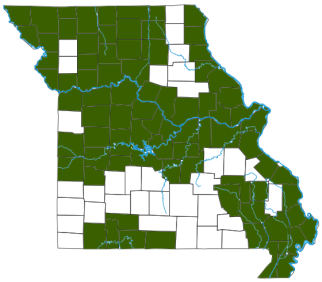
Nearly statewide; primarily in the Missouri and Mississippi rivers and their major tributaries, but uncommon in the Ozarks.
Habitat and Conservation
Midland smooth softshells live mainly in rivers and larger streams, especially the Missouri and Mississippi rivers, usually with moderate to fast current, and abundant sand or mud. They are powerful swimmers.
This species is somewhat of a habitat specialist (large rivers with sandbanks and sand islands for egg laying) and occurs at relatively low numbers in Missouri.
In the lower Mississippi River of southeast Missouri, they are most abundant along the border of the main channel and open side channels.
The midland smooth softshell is active from early April to mid-October in Missouri.
This species is more aquatic than other softshell turtles and spends considerable time in the water. When basking, it will usually do so on a gentle shoreline slope along a sandbar or mud flat within about 3 feet from the water’s edge. The slightest disturbance will cause it to quickly dash into the water for protection.
Softshells are active during the daylight hours and search for food during the morning and late evening.
When resting, they will bury themselves in mud or sand in shallow water with only the head and neck exposed. The turtle buries itself by diving head first into loose substrate using its powerful front and hind limbs to get deeper within the substrate. The turtle then stirs up the bottom substrate by a shuffling motion that allows the loose materials to settle over the turtle, concealing the shell with only its head slightly visible. Air is taken in by protruding the tip of the snorkel-like snout out of the water. In this manner, the turtles are inconspicuous.
These turtles also can remain submerged and carry on gaseous exchange from the water by pumping water in and out of the mouth and the cloaca (anal opening).
Softshells protect themselves from freezing weather by burying themselves in the mud of the river bottom.
Food
This species is primarily carnivorous, feeding mainly on fish, crayfish, salamanders, tadpoles, frogs, snails, and aquatic insects. They mainly sit and wait under loose substrate with only the head partially exposed to ambush prey by extending their long neck. Softshells will also eat plant materials such as mulberries and cottonwood seeds when available.
Male and female turtles may differ significantly in types of food eaten. One study showed that up to 71 percent (by volume) of prey eaten by females consisted of aquatic insect larvae captured in deep water. Male softshells consumed terrestrial insects (67 percent by volume) that fall into the water along the shoreline.
Although softshells may prey upon nearly any species of fish, there is no evidence to show that they harm fish populations in natural waters.
Status
In recent years, smooth softshells appear to be declining in a number of midwestern states. Channelization of rivers (altering the river flow and reducing egg-laying sites), water pollution, increased predation of nests, and overharvesting have likely impacted this species.
Softshells are classified as game species in Missouri. To maintain healthy populations of these interesting reptiles, the Missouri Department of Conservation regulates a season and bag limit on them. Consult the most recent Wildlife Code of Missouri for current regulations.
Life Cycle
This species is active from early April to mid-October. Breeding occurs in April and May, and egg-laying takes place from late May into July. Females typically lay 2 clutches per season, with the first clutch containing more eggs than the second. Larger females lay more eggs than smaller ones. A clutch may contain 3–26 eggs, with an average of 18. Females dig their nests in a sandbank, sandbar, or river island with exposure to the sun, within 100 feet of the water, on higher ground about 3–5 feet above the water level. The nest holes are 6–12 inches deep. Hatching occurs in 68–70 days. The shells of hatchlings are 1¼–2 inches long.
Females become sexually mature at about 6–9 years of age, males at about age 4. Lifespan is assumed to be more than 20 years.
Human Connections
Both of Missouri's softshell species are considered game animals in our state. Recent studies have shown that unlimited harvest of softshells is not sustainable, and regulations were enacted in 2018 to eliminate the unlimited commercial harvest of softshells in Missouri. There is a season and daily bag limit to allow a small number of softshells to be captured on hook-and-line by recreational anglers for local food, however. These regulations will help to ensure that softshells remain common in Missouri's rivers.
As a game species with delicious meat, softshell turtles are economically valuable as a human food source. Indeed, members of the softshell family are eaten by people worldwide. Make sure you know the current regulations regarding their harvest.
Though softshells have notoriously strong jaws and should always be handled with caution, smooth softshells are less inclined to bite when captured compared to spiny softshells.
Ecosystem Connections
Although softshells may prey upon nearly any species of fish, there is no evidence to show that they harm a fish population in natural waters. Like other components of our native aquatic ecosystems, they contribute to the balance of nature.
Researchers in Iowa compared the foraging habits of smooth and spiny softshells. They found that spiny softshells are less specialized in their habitat requirements than smooth softshells. Spiny softshells searched for food on the bottom, while smooth softshells located food in the water column.
To defend themselves, softshells compensate for the lack of a hard shell and scutes by having strong jaws and by being fast swimmers. Softshells also use their strong, sharp claws to defend themselves.
Members of the softshell family (Trionychidae) occur in North America, Asia, and Africa. The family has 31 species in 13 genera. Only one genus, Apalone, with three species, occurs in the United States. Softshells are well-equipped for an aquatic life. They are round and flat; their upper and lower shells are covered with skin; they lack scutes (shell scales); they have a long, tubular snout that functions like a snorkel; and there is extensive webbing on all four limbs.

